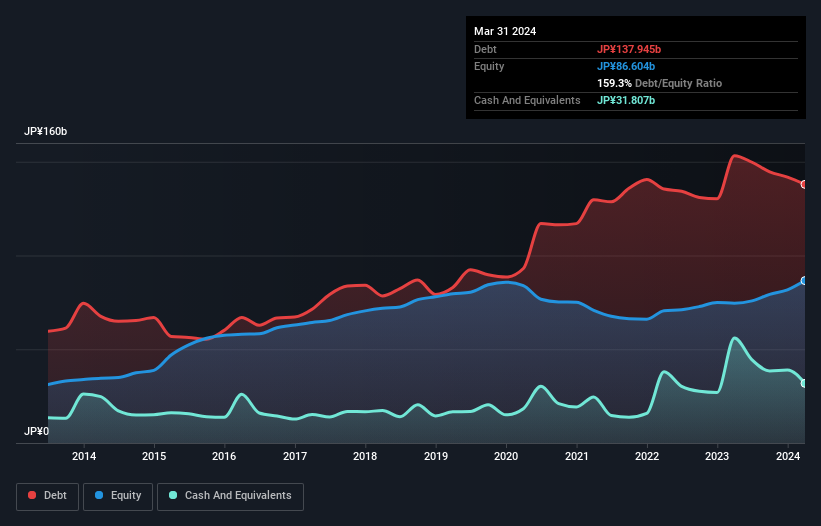
The external fund manager backed by Berkshire Hathaway's Charlie Munger, Li Lu, makes no bones about it when he says 'The biggest investment risk is not the volatility of prices, but whether you will suffer a permanent loss of capital.' So it seems the smart money knows that debt - which is usually involved in bankruptcies - is a very important factor, when you assess how risky a company is. We can see that Kyoritsu Maintenance Co., Ltd. (TSE:9616) does use debt in its business. But should shareholders be worried about its use of debt?
When Is Debt A Problem?
Generally speaking, debt only becomes a real problem when a company can't easily pay it off, either by raising capital or with its own cash flow. Ultimately, if the company can't fulfill its legal obligations to repay debt, shareholders could walk away with nothing. However, a more usual (but still expensive) situation is where a company must dilute shareholders at a cheap share price simply to get debt under control. Having said that, the most common situation is where a company manages its debt reasonably well - and to its own advantage. The first step when considering a company's debt levels is to consider its cash and debt together.
Check out our latest analysis for Kyoritsu Maintenance
What Is Kyoritsu Maintenance's Debt?
As you can see below, Kyoritsu Maintenance had JP¥137.9b of debt at March 2024, down from JP¥153.2b a year prior. However, it does have JP¥31.8b in cash offsetting this, leading to net debt of about JP¥106.1b.

How Strong Is Kyoritsu Maintenance's Balance Sheet?
We can see from the most recent balance sheet that Kyoritsu Maintenance had liabilities of JP¥71.1b falling due within a year, and liabilities of JP¥113.2b due beyond that. On the other hand, it had cash of JP¥31.8b and JP¥17.9b worth of receivables due within a year. So its liabilities outweigh the sum of its cash and (near-term) receivables by JP¥134.7b.
While this might seem like a lot, it is not so bad since Kyoritsu Maintenance has a market capitalization of JP¥231.7b, and so it could probably strengthen its balance sheet by raising capital if it needed to. However, it is still worthwhile taking a close look at its ability to pay off debt.
We measure a company's debt load relative to its earnings power by looking at its net debt divided by its earnings before interest, tax, depreciation, and amortization (EBITDA) and by calculating how easily its earnings before interest and tax (EBIT) cover its interest expense (interest cover). The advantage of this approach is that we take into account both the absolute quantum of debt (with net debt to EBITDA) and the actual interest expenses associated with that debt (with its interest cover ratio).
Kyoritsu Maintenance's net debt is 4.5 times its EBITDA, which is a significant but still reasonable amount of leverage. However, its interest coverage of 42.6 is very high, suggesting that the interest expense on the debt is currently quite low. Notably, Kyoritsu Maintenance's EBIT launched higher than Elon Musk, gaining a whopping 128% on last year. There's no doubt that we learn most about debt from the balance sheet. But ultimately the future profitability of the business will decide if Kyoritsu Maintenance can strengthen its balance sheet over time. So if you're focused on the future you can check out this free report showing analyst profit forecasts.
Finally, a company can only pay off debt with cold hard cash, not accounting profits. So we clearly need to look at whether that EBIT is leading to corresponding free cash flow. Over the most recent three years, Kyoritsu Maintenance recorded free cash flow worth 71% of its EBIT, which is around normal, given free cash flow excludes interest and tax. This free cash flow puts the company in a good position to pay down debt, when appropriate.
Our View
Happily, Kyoritsu Maintenance's impressive interest cover implies it has the upper hand on its debt. But the stark truth is that we are concerned by its net debt to EBITDA. All these things considered, it appears that Kyoritsu Maintenance can comfortably handle its current debt levels. On the plus side, this leverage can boost shareholder returns, but the potential downside is more risk of loss, so it's worth monitoring the balance sheet. When analysing debt levels, the balance sheet is the obvious place to start. However, not all investment risk resides within the balance sheet - far from it. For example, we've discovered 1 warning sign for Kyoritsu Maintenance that you should be aware of before investing here.
At the end of the day, it's often better to focus on companies that are free from net debt. You can access our special list of such companies (all with a track record of profit growth). It's free.
Valuation is complex, but we're here to simplify it.
Discover if Kyoritsu Maintenance might be undervalued or overvalued with our detailed analysis, featuring fair value estimates, potential risks, dividends, insider trades, and its financial condition.
Access Free AnalysisHave feedback on this article? Concerned about the content? Get in touch with us directly. Alternatively, email editorial-team (at) simplywallst.com.
This article by Simply Wall St is general in nature. We provide commentary based on historical data and analyst forecasts only using an unbiased methodology and our articles are not intended to be financial advice. It does not constitute a recommendation to buy or sell any stock, and does not take account of your objectives, or your financial situation. We aim to bring you long-term focused analysis driven by fundamental data. Note that our analysis may not factor in the latest price-sensitive company announcements or qualitative material. Simply Wall St has no position in any stocks mentioned.
About TSE:9616
Solid track record and good value.
Market Insights
Community Narratives




